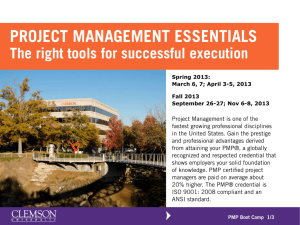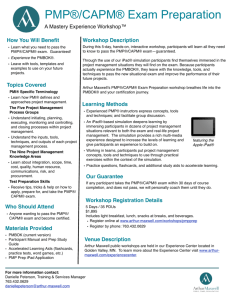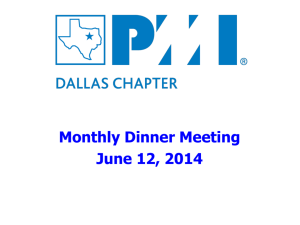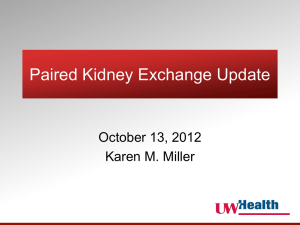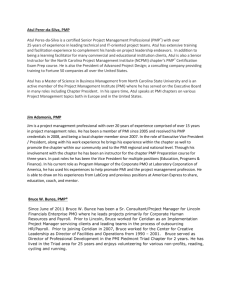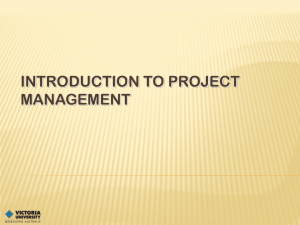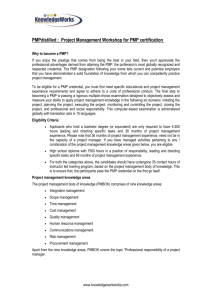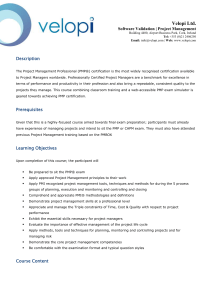PMP Preparation Overview
advertisement
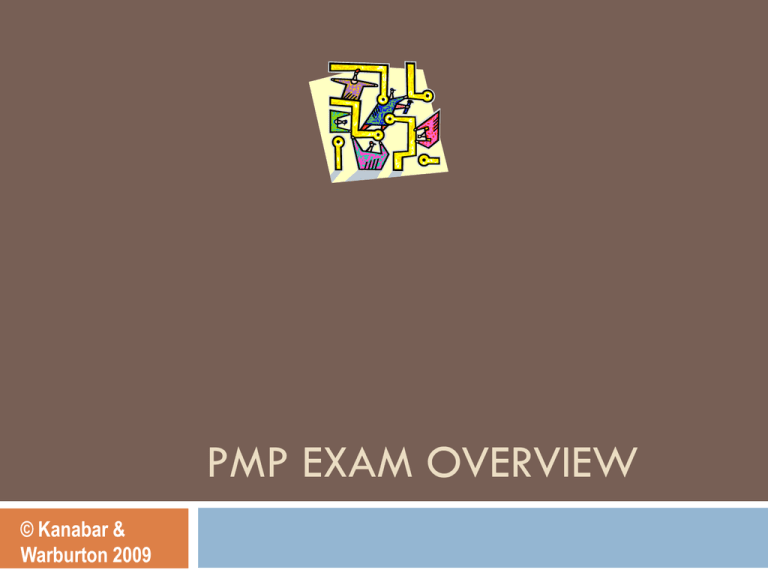
PMP EXAM OVERVIEW © Kanabar & Warburton 2009 PMP Exam Overview 2-2 o How to become certified. o Application Process o Sample Exam questions. Professional Responsibility (Ethics) Are You Eligible? 2-3 Review the eligibility requirements for taking the PMP® Certification Exam online. For students considering the PMP credential, we recommend the following approach. First, to be eligible to earn the PMP you must pre-qualify: High School/Equivalent – Path 1 Bachelors Degree – Path 2 Path 2 2-4 4,500 hours of experience in project management within the 5 process groups At least 3 years (36 months) experience within the 6 year period prior to application Forms 2-5 Experience verification forms Project Management Education form Complete examination application with the appropriate application fee for PMI® members $555 for non-members $405 Exam 2-6 200 multiple choice questions to be answered in 4 hours. Of these, 25 are test questions used to evaluate future questions and are not counted in your score. There is a 15 minute tutorial before the test, which explains how everything works. PMI administers the test through Computer Based Testing (CBT). The entire process of application, payment, and scheduling of the test is easily accomplished on line through the PMI website. Number of Questions: Break Down 2-7 Domains I. Initiating the Project 11 II. Planning the Project III. Executing the Project IV. Monitoring and Controlling the Project V. Closing the Project VI. Professional Responsibility % of questions 11 23 27 21 9 9 Studying for the PMP Exam 2-8 Questions on the test break down into 3 categories: Definitional, Computational, and Scenario based We have found that for our students (and ourselves!) the best approach is: Take a required course first. Read the PMBOK. Read recommended resources. Participate in a paced-workshop. Rita Mulcahy 2-9 PMP® Exam Prep, by Rita Mulcahy, PMP. © RMC Publications, Inc., 2008. Best choice. Rita’s book takes a lot of time to master. Her approach is based on memorizing a large process chart, which allows you to figure out the inputs and outputs to the 42 processes. Other Choices 2-10 PMP® Exam Practice Questions and Solutions, by Aileen Ellis, PMP. © AME Group, 2005. This book contains a series of questions that are well organized into sections corresponding to the PMBOK processes. This book will ensure that you clearly understand the basics. Note: Read a current edition. PMP Head-First 2-11 Head First PMP Greene and Stellman Friendly book. Make sure you have the current edition. Ethics & Professional Responsibility 2-12 Ensure integrity Contribute to knowledge base Apply professional knowledge Balance stakeholder interests Respect differences Ethics & Professional Responsibility 2-13 Adhere to the Project Management Professional Code of Professional Conduct Avoid all conflicts of interest Personal gain should never be a consideration Maintain Integrity: Be ethical and professional at all times. Whistle-blowing Contribute to the Knowledgebase 2-14 Share lessons learned, best practices, and research Improve the quality of project management services Build capabilities of colleagues through coaching, mentoring, and training This is encouraged even after certification. Domain Questions: Initiating 2-15 Planning 2-16 Executing 2-17 Monitor and Control 2-18 Closing 2-19 Studying 2-20 Make a spreadsheet with key concepts. Understand key concepts well. Make a separate page for that. See example on the next page. Create cards with terminology Practice questions (see book) Concepts (example) 2-21 • • • Crashing and fast tracking are two techniques for shortening project schedules. Which is more risky? Critical chain scheduling is an application of the Theory of Constraints (TOC) that uses critical path analysis, resource constraints, and buffers to help meet project completion dates. The Program Evaluation and Review Technique (PERT) is a network analysis technique used to estimate project duration when there is a high degree of uncertainty about the individual activity duration estimates. It uses optimistic, most likely, pessimistic estimates of activity durations. Program Evaluation and Review Technique (PERT) • • It applies the critical path method (CPM) to a weighted average duration estimate. • PERT uses probabilistic time estimates: optimistic, most likely, and pessimistic (three point estimate) • • • • 2-22 A network analysis technique used to estimate project duration when there is a high degree of uncertainty about the individual activity duration estimates. PERT weighted average = optimistic time + 4 * most likely time + pessimistic time __________________________________________ 6 By using the PERT weighted average for each activity duration estimate, the total project duration estimate takes into account the risk or uncertainty in the individual activity estimates. Advantage: It attempts to address the risk associated with duration estimates. Since many projects exceed schedule estimates, PERT may help in developing schedules that are more realistic. Disadvantage: It involves more work than CPM since it requires several duration estimates, and there are better probabilistic methods for assessing schedule risk. (i.e. Monte Carlo Analysis) Exam Cram Handout 2-23 Please study the color printed cram card given to you separately. Thank You! 2-24 We know you will do well. Call us when you graduate! We will be there to celebrate


